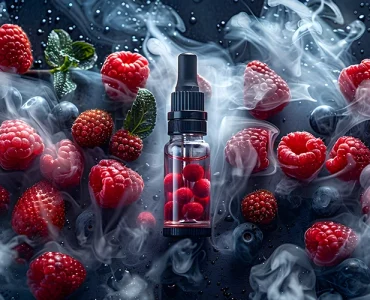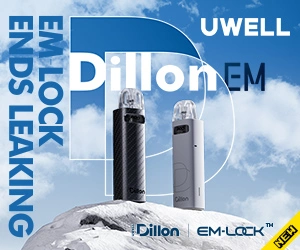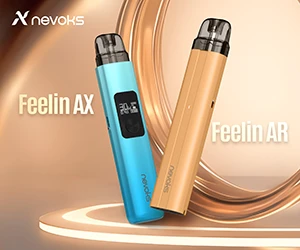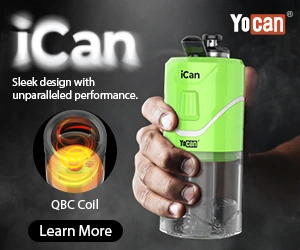Key Takeaways
- E-liquid generally contains four main ingredients: Propylene glycol (PG), vegetable glycerin (VG), food-grade flavorings, and nicotine. Both PG and VG are FDA-approved ingredients used in many foods and medicines.
- Cigarette smoke contains thousands of chemicals, at least 70 of which are known carcinogens. The CDC estimates that tobacco smoking kills over 480,000 people in the United States each year.
- There have been no deaths reported to be definitively caused by vaping nicotine-based liquids alone. As approximately 8% of the US population (27 million people) use a vape regularly, that’s a striking statistic.
- The opinion on the dangers of vaping compared to smoking varies around the world. The Royal College of Surgeons has suggested that vaping is likely to be 95% less dangerous to health than smoking tobacco.
The question of whether vaping is bad for you is a big one. Arguably one of the biggest if you are considering switching from smoking to using a vape. Unfortunately, the answer isn’t a simple yes or no.
Vapes were initially designed to be a safer alternative to smoking cigarettes. They have been made even safer over the last couple of decades. But vaping has never been sold to us as entirely healthy and no responsible person (doctor, scientist, or otherwise) should ever tell you that it has zero risk.
So to even begin to answer this crucial question, we have to look at what vaping is, how vaping compares to smoking, and the potential risks involved in each activity.
The Basics of an E-Cigarette
An e-cigarette or vape is a small, battery powered, portable device. Some vapes have a built-in tank, while others have tanks that are external. These tanks are then filled with e-liquid or e-juice, which consists of propylene glycol and/or vegetable glycerin, food grade flavoring, and optionally nicotine. The coil inside of the vape heats the e-juice into vapor, which is then inhaled by the user.
Compared with traditional analog cigarettes that contain thousands of harmful chemicals, e-juice purchased from a reputable supplier has only a handful of main ingredients. These ingredients are:
- Propylene Glycol (PG) and/or Vegetable Glycerin (VG)
- Food Grade Flavorings
- Nicotine (optional)
Propylene Glycol (PG) and Vegetable Glycerin (VG) are the main ingredients in any vape juice. An e-juice may contain one or both of these ingredients depending on the desired qualities of the juice. Both propylene glycol and vegetable glycerin are FDA approved ingredients and common in many foods and medicines that we use today.
Propylene Glycol
Propylene glycol (PG) is a viscous, colorless liquid with a faint, sweet taste. PG is what produces the “throat hit” that many smokers crave. Higher ratios of PG generally mean a heavier throat hit. PG also carries flavorings more effectively than VG does.
PG is “generally recognized as safe” by the United States Food and Drug Administration, and sees wide use in food processing, pharmaceuticals, and even in asthma inhalers. Additionally, according to the Health Canada website, “…there are no endpoints of concern for oral, dermal or inhalation exposure to propylene glycol”.
Vegetable Glycerin
Similar to propylene glycol, vegetable glycerin (VG) is “generally recognized as safe” by the FDA. It is also colorless and viscous and commonly produced from plant oils such as palm, soy, or coconut oil. VG is sweet, but with a slightly different taste than PG.
Vegetable Glycerin is effective at carrying flavorings and nicotine. However, compared to PG, VG is much denser and considerably thicker. VG is therefore used in higher ratios when cloud production is an important factor. Vegetable glycerin sees use in beauty products such as shampoos and soaps, in toothpaste, as well as in foods.
Food Grade Flavorings
The food grade flavorings used in e-juices are just that; food grade. This means that they are suitable for ingestion, but there isn’t enough research to definitively say that they are safe to be inhaled.
With that being said, there also isn’t any evidence showing that inhaling these flavorings is harmful. More research will need to be done in the future in order to provide a concrete answer. What we can say is that, when compared with the chemicals in a cigarette that are known to cause cancer, it’s probably safe to say that vaping food grade flavorings is safer than smoking.
Nicotine
Nicotine gets a bad reputation from being associated with cigarettes. While it is technically a poisonous substance in high concentrations, it isn’t as bad as you might think. Perhaps the worst quality of nicotine is that it is a highly addictive substance. This being said, nicotine should only be enjoyed by responsible, legal adults.
The nicotine used in e-liquids is the same nicotine that is used in other smoking cessation products such as nicotine patches and gums. Nicotine is similar in effect to caffeine, in that it is a mild stimulant that increases heart rate and elevates your blood pressure.
While many think that nicotine is what causes cancer, this is not the case. It is not the nicotine in cigarettes that causes cancer, but rather the tar that is produced from the combustion of chemicals and material formed when a cigarette burns.
Common nicotine contents of ejuices are: 3mg/ml, 6mg/ml, and 9mg/ml. There are also ‘nicotine salt’ ejuices available that contain higher concentrations of nicotine such as 25mg/ml all the way up to 50mg/ml.
Alternatively, those looking to lower their nicotine consumption or quit altogether can choose from thousands of e-liquids that contain zero nicotine.
Is Vaping Worse Than Smoking?
When a cigarette is burned it releases over 5,000 different chemicals, and more than 70 may cause cancer, according to the American Cancer Society. Among these chemicals are: benzene, arsenic, formaldehyde, cadmium, chromium, and many more. According to the CDC, there are around 480000 deaths per year from smoking in the United States (including deaths caused by second-hand smoke.)
Current statistics covering deaths associated with vaping are harder to find. There were around 70 deaths linked to Vitamin E Acetate in black-market THC cartridges in 2019-20, but as far as we are aware, that was an isolated problem.
To date, there appear to have been no deaths reported to be caused by vaping nicotine-based liquids alone. That is a striking statistic (or lack of statistic) considering that approximately 8% of the US population, or around 27 million people, use a vape regularly.
There are concerns that we don’t yet have the data available to say how harmful vaping could be in the long term. Science does not yet know what years of exposure to vape ingredients will do to a person. This may be true, but it is hard to believe that 20 years of vaping would have anything close to the same effect on health as 20 years of smoking has.
The highly-respected Royal College of Surgeons has stated that “the hazard to health arising from long-term vapor inhalation from the e-cigarettes available today is unlikely to exceed 5% of the harm from smoking tobacco.” And they have access to more data, studies, and research than we might hope to find.
Some governments are now actively supporting the belief that vaping is a better alternative to smoking and can be used as a viable cessation device. In the UK, there is even a plan to give away free vapes to millions of smokers called Swap to Stop.
Based on the currently available evidence, the answer to this question is clear: No, vaping is not worse than smoking. But even as long-time vapers who have no regrets about switching from smoking, we aren’t going to tell you that using vapes is totally harmless.

Does Vaping Cause Lung Cancer?
It has been understood for a long time that smoking is one of the leading causes of lung cancer. It can also be responsible for more than 15 other types of cancer. Cancer in any part of the body starts when our cells mutate and divide in abnormal or uncontrollable ways. This can be caused by a genetic defect or the DNA of cells getting damaged.
Cigarettes can contain hundreds of different chemicals, at least 70 of which are known to cause cancer. When a cigarette is smoked, these chemicals are taken directly into the lungs or converted into tar, Carbon Monoxide, Hydrogen Cyanide, and other similarly dangerous compounds during the burning process. Once in the tissues of your lungs, they immediately start attacking cells and causing abnormal cell changes.
The more often the same cells in your lungs are attacked and damaged, the more likely they will start dividing abnormally in response. And in some cases, the mutated cells will develop into cancerous growths or tumors.
Vaping is different from smoking in several ways. Firstly, there are far fewer chemicals in vape liquids than are found in a cigarette. And when you vape, the liquid is converted into vapor (or aerosolized) without burning, meaning compounds like tar and carbon monoxide aren’t created in the process.
Although it can again be argued that vaping has not been studied long enough to fully understand its long-term effects, there is currently no evidence that it causes lung cancer. Vape liquids can contain harmful chemicals and even some carcinogens, but crucially, not at levels anywhere near those found in tobacco smoke.
Does Vaping Damage Your Lungs?
There are, of course, other ways your lungs can be damaged aside from cancer. Conditions such as Bronchiolitis Obliterans (Popcorn Lung) and Lipoid Pneumonia have been linked to some of the ingredients used in vape liquids. So, should you be worried?
Both popcorn lung and lipoid pneumonia, which can occur when the vapor or smoke enters and inflames lung tissue, are very rare. That is true of society in general, as well as in people who vape.
There have been no cases of popcorn lung where normal vaping has been proven to be the primary cause. Diacetyl, the ingredient linked to this undeniably severe disease, is now rarely used in good-quality vape liquids. It is worth knowing that Diacetyl is also present in tobacco smoke, at levels between 100-750 times higher than in vape liquid.
What about the other ingredients in vape liquid? Research conducted by Johns Hopkins concluded that certain vape juice flavors, such as cinnamon, can cause inflammation in the lungs of mice. However, there seems to be little evidence that this is a common complaint in humans.
The Propylene Glycol (PG) used in almost all vape liquids is known to cause an allergic reaction in some people, including minor inflammation of the airways. Once again, not enough research has been done on why this happens, but PG-intolerant vapers always have the option to use low or zero-PG liquids.
In almost all cases, lung and airway damage being caused by vaping is due to devices or e-liquids that have been adapted unsafely by the user, or sourced from disreputable vendors. In others, extreme vaping habits were the problem. Vaping responsibly, and using liquids and devices purchased from a reputable source, will go a long way towards making it safer.
Is Vaping Bad for Your Teeth?
Smoking tobacco has long been proven to be bad for oral health. The chemicals and carcinogens found in cigarettes can attack the mouth almost as much as they attack the lungs and heart. Tar and other substances in smoke stain teeth and can lead to oral infection if they build up in the mouth.
Although vaping does not contain or produce the same amount of chemicals and cancer-causing ingredients, it can still have an effect on your oral health. If allowed to build up in the mouth, vape liquid ingredients could accelerate bacteria growth and lead to gum disease. Of course, that is also true of almost everything you put in your mouth.
Vape liquid ingredients, such as PG and VG, can build up on the teeth. If you use a colored liquid, it can lead to tooth staining. Because tooth decay is the result of sugars and acids reacting with the tooth enamel, the sweeter your vape liquid, the more likely it is to damage your beautiful smile.
Oral dehydration, one of the better-known side effects of vaping, can increase the chance of developing sores or abrasions in the mouth. In turn, these could damage gums or other soft tissue. Ensuring you stay hydrated when vaping is important and will reduce the chance of this happening.
Finally, we come to nicotine. Nicotine has been shown to reduce blood flow to the gums. This can cause them to recede and lead to gum disease and root damage. Obviously, cigarettes also contain nicotine, so this isn’t a problem only for vapers. Vaping, at least, makes it easier to reduce your nicotine intake or cut it out altogether by using low or zero-nicotine liquids.
Good oral hygiene can reduce or even remove the risks to your mouth and teeth from vaping, as will using colorless vape liquid and avoiding those extra-sweet flavors. It is not as easy to protect your teeth from the effects of smoking cigarettes.
Second-Hand Vape Effects
When a cigarette is burning in an ashtray, or you exhale the smoke, organic particles, chemicals, and carcinogens are released into the air for others to inhale. Smoke is defined as: “a visible suspension of carbon or other particles in air, typically one emitted from a burning substance.”
Vaporizing a substance only changes it from one form to another (liquid to gas) while retaining its chemical composition. When you exhale a vape, the vapor only contains the ejuice ingredients in gas form. Because as much as 95% of the nicotine in a puff is absorbed, little other than PG, VG, and flavorings get into the air.
Vapor may appear to hang around in the air longer than smoke, but it is less likely to leave residue on surfaces. Any residue left behind is essentially going to be VG, PG, and a small amount of nicotine. It won’t include the tar and other dangerous chemicals that tobacco residue contains.
However, you should still vape responsibly around others. Vapor in the air can be inhaled by other people, and it can still contain nicotine. Vaping around small children or pregnant women isn’t something you should be doing.
Does Vaping Cause Acne?
While it is unlikely that vaping will cause acne in anyone who isn’t already prone to suffering from skin conditions, it could inflame or worsen an existing condition. As yet, little in-depth research has been done on this, so much of the evidence is anecdotal.
One of the known side effects of vaping is dehydration, not only inside your mouth but also in your skin. When your skin dehydrates, it can become more susceptible to irritation and potentially lead to an outbreak of acne.
The oil-like ingredients found in most vape liquids, Propylene Glycol (PG) and Vegetable Glycerin (VG,) can also cause skin irritation in some people, which can further inflame skin pores and lead to acne. That means that while neither PG nor VG is comedogenic (they don’t clog skin pores,) reducing the amount of PG in your vape liquid could help to avoid this type of skin condition.
The Bottom Line
It would be irresponsible of us to say that vaping is entirely harmless. Nor would it be correct to say that vaping is safer for everyone equally. Children, pregnant women, and anyone with an existing lung condition should avoid vaping just as much as smoking.
Almost everything you put into your body has the potential to be bad for you, but cigarette smoke has long been proven to be just about the worst. Smoking can damage almost every part of your body, inside and out. The same cannot be said for vaping, which so far hasn’t been definitively linked with any significant health problems.
Research into the long-term effects of vaping is ongoing, and the amount of studies is increasing as vaping becomes more popular. But even if it is impossible to say that vaping is 100% safe, based on the vast majority of evidence available today, it is clearly safer than smoking tobacco.










Add comment